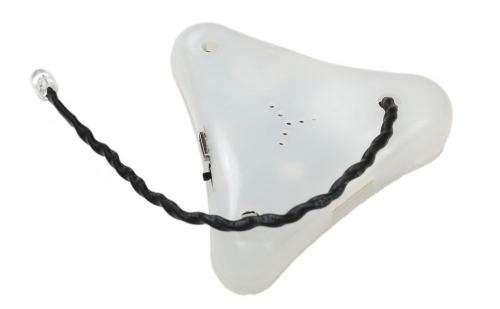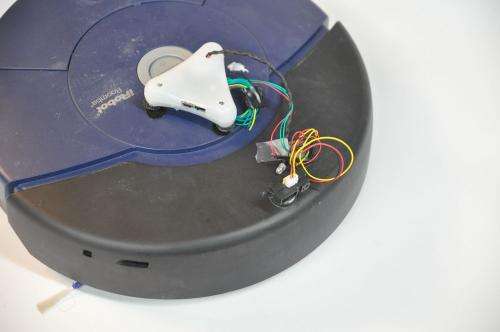December 16, 2011 report
Brainlink controller smartens dust-collecting robots: Let's Roomba

(PhysOrg.com) -- A Carnegie Mellon spinoff has introduced a triangle shaped connector that can make simple little robots behave in a more sophisticated way and can otherwise transform an Android smartphone into a TV and gadget remote. The device is called Brainlink and it talks to Android phones or laptops via Bluetooth. The controller has a Bluetooth range of 30 feet.
The company, BirdBrain Technologies, announced the product in a release dated December 14 and since then gadget-focused bloggers have been enthusing over a home robotics future. The device can make a Roomba more adept at moving around without bumping into walls and the device can be used to train a simple robot to fetch the user something.
Basically, Brainlink can deliver new capabilities to toy robots and other gadgets operated with infrared (IR) remote controls. The device enables programming and wireless control of whatever it is attached to. Brainlink users can write programs for robots that have limited “brains” to start with and thereby expand their capabilities and can also control items such as VCRs with IR remotes.
According to the company, the device can decode, visualize, and replicate the signals of most infrared remotes. The unit is powered by a rechargeable battery. Three built-in sensors include an Axis Accelerometer to help detect orientation, shaking, and tapping; a Photodiode, to read the amount of light reaching the sensor and Battery Voltage. to allow host programs to detect low battery states (less than 3.5V).

Brainlink uses the Bluetooth RN-42 module to communicate between its microcontroller and the smartphone or laptop.
Users who write their Android apps for the Brainlink write them in Java and then can test them out on any Bluetooth equipped Android device. End uses suggested by BirdBrain have no doubt encouraged the numerous enthused reviews, including: “Create an Android App that uses object recognition and voice analysis to find you a beer - you'll probably need to place your phone on the robot to make this work well.” Other end uses are using voice commands to control a TV, and, back to the robots, using a toy robot to add light or sound.

BirdBrain Technologies is pricing Brainlink at $125. The company’s target audience is both home hackers and educators. Ordering a robot to fetch beer may not seem conducive to learning environments, but the product is a result of a team mission to produce a more intuitive interface for educational robots.
Observing the dozens of cheap robots on the market with no desirable interfaces for students, the company wanted firmware inside Brainlink to be open source and hackable. “Though it's possible to use the pre-made apps to use Brainlink, to, for example, control most toy robots from an Android phone, we think that those who will fully enjoy Brainlink are hackers with an intermediate level of programming experience,” according to the company’s site. “If you've taken one high school or college CS class, you should have no trouble with it.”
CMU’s CREATE Lab also had a hand in the product. CREATE stands for Community Robotics, Education and Technology Empowerment. The software for Brainlink was developed by Christopher Bartley, principal research programmer in the CREATE Lab and Huaishu Peng, a student in the School of Architecture’s Tangible Interaction Design program.
More information:
news.cs.cmu.edu/article.php?a=2876
www.brainlinksystem.com/
© 2011 PhysOrg.com





















